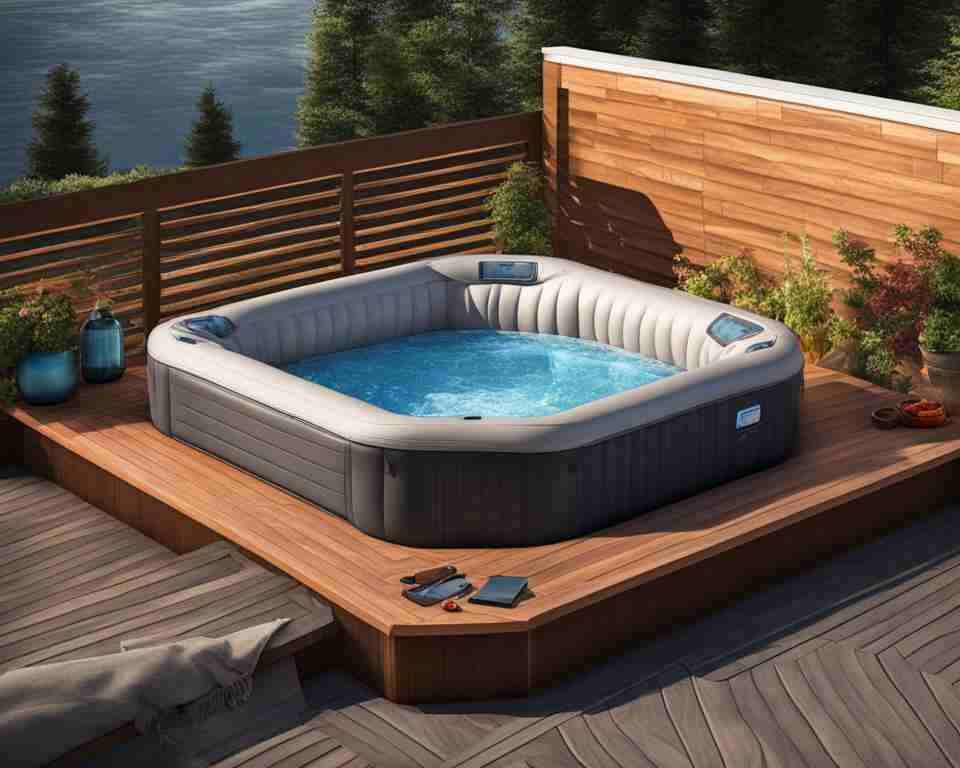As a hot tub enthusiast, I often find myself seeking the perfect spot to enjoy a soothing soak in the comfort of my own backyard. Placing an inflatable hot tub on a deck seems like an ideal solution, offering convenience and relaxation all in one.
However, before settling on this setup, it’s crucial to consider the safety aspects involved. Is it safe to place an inflatable hot tub on a deck? Let’s explore the factors that determine deck compatibility, weight capacity, and necessary reinforcements to ensure a secure and stable environment for your hot tub.
Key Takeaways:
- Assess the weight capacity of your deck before placing an inflatable hot tub to prevent structural failures.
- Consider the material compatibility of your deck with the hot tub to ensure stability and longevity.
- Take necessary steps for deck installation, including leveling and proper placement of the hot tub.
- Prioritize deck safety by conducting regular inspections and implementing protective treatments.
- If needed, consult a professional for deck reinforcement strategies to accommodate the weight of the hot tub.

Can I Put an Inflatable Hot Tub on a Deck?
Placing an inflatable hot tub on a deck is indeed possible, but several factors need to be considered to ensure the safety and stability of the setup. The weight capacity of the deck, the material compatibility of the deck with the hot tub, and the need for deck reinforcement are all crucial factors to evaluate. By understanding these considerations, you can determine whether your deck is suitable for accommodating an inflatable hot tub and take the necessary steps to ensure a secure installation.
When it comes to placing an inflatable hot tub on a deck, one of the primary concerns is the weight capacity of the deck. Decks are designed to support a certain amount of weight, and exceeding this weight limit can lead to structural damage and safety hazards. It is essential to check the manufacturer’s specifications for the hot tub’s weight when filled with water and the weight capacity of your deck. This information will help you determine if your deck can safely support the hot tub’s weight.
Additionally, it is crucial to consider the material compatibility of your deck with the hot tub. Some decking materials, such as composite or pressure-treated wood, may be better suited for supporting the weight of an inflatable hot tub. It is recommended to consult with a decking professional or the hot tub manufacturer to ensure that your deck’s material is suitable for the installation of an inflatable hot tub.
In some cases, deck reinforcement may be necessary to ensure a secure placement for your inflatable hot tub. This may involve adding additional support beams or joists to increase the weight-bearing capacity of the deck. Consulting with a professional deck builder or contractor can help you determine if deck reinforcement is required and provide guidance on the necessary modifications.
By carefully evaluating the weight capacity of your deck, checking the material compatibility, and considering the need for deck reinforcement, you can determine whether it is safe to put an inflatable hot tub on your deck. Taking these precautions will help ensure a secure and stable installation, allowing you to enjoy the relaxation and convenience of an inflatable hot tub in the comfort of your own deck.
Assessing Deck Weight Capacity for Inflatable Hot Tubs
Understanding Your Deck’s Load Capacity
Calculating Your Hot Tub’s Total Weight
To determine whether your deck can handle the weight of an inflatable hot tub, you need to calculate the total weight of the hot tub. This includes the weight of the empty tub itself, the weight of the water required to fill it, and the weight of the occupants.

Considering the Weight of Water and Occupants
The weight of water and occupants in the hot tub can significantly contribute to the overall load on your deck. Water weighs about 8.34 pounds per gallon, and the average weight of occupants can vary. By estimating the gallons of water your hot tub holds and the average weight of the occupants, you can determine the additional load.
Calculating the deck weight capacity for inflatable hot tubs requires precision and attention to detail. By considering these factors, you can ensure the safety and stability of your deck while enjoying the relaxation of your inflatable hot tub.
Material Compatibility of Decks with Inflatable Hot Tubs
The Impact of Decking Materials on Weight Support
The type of material used for your deck plays a crucial role in determining its weight support capabilities when accommodating an inflatable hot tub. Different decking materials have varying weight-bearing capacities, so it’s important to choose wisely.
Composite decking materials, for example, are renowned for their durability and ability to mimic the look of real wood while providing excellent weight support. These materials are engineered to withstand heavy loads and are highly resistant to warping, rotting, and discoloration. If you’re looking for long-term stability and longevity for your deck, composite materials are a great option.
On the other hand, pressure-treated wood is a more budget-friendly option but may not offer the same level of durability. While pressure-treated wood can handle moderate weight loads, it may be more prone to warping and discoloration over time. Regular maintenance, such as staining and sealing, may be required to keep the wood in good condition.
Choosing the Right Material for Deck Longevity
When selecting the material for your deck, it’s important to consider both immediate weight support and long-term deck longevity. While certain materials may offer adequate weight support for an inflatable hot tub, they may not be as durable or resistant to the elements, resulting in a shorter deck lifespan.
Composite decking materials, as mentioned earlier, are a great choice for both weight support and longevity. These materials are designed to withstand heavy loads and are often backed by warranties that guarantee their performance for several decades. They are also highly resistant to moisture, insects, and other environmental factors, which can significantly extend the lifespan of your deck.
Alternatively, hardwoods such as Brazilian walnut and teak are naturally resistant to rot and decay, making them durable choices for deck construction. However, these materials can be more expensive and may require regular maintenance to retain their integrity over time.
| Decking Material | Weight Support | Longevity |
|---|---|---|
| Composite | Excellent | Excellent |
| Pressure-treated wood | Moderate | Moderate |
| Hardwoods | Good | Good |
Deck Installation Considerations for Inflatable Hot Tubs
When installing an inflatable hot tub on a deck, there are several important considerations to keep in mind. The deck should be properly prepared and leveled to ensure a stable foundation for the hot tub. Additionally, access to the deck, as well as the placement of the hot tub in relation to the deck layout and surrounding areas, should be taken into account.
Before proceeding with the installation, it is crucial to assess whether the deck can support the weight of the hot tub and its occupants. Consider the weight capacity of the deck and compare it to the total weight of the hot tub, including the weight of water and occupants. If the deck’s weight capacity is not sufficient, it may be necessary to reinforce the deck with additional support beams and joists.
Once you have determined that the deck is suitable for the installation, ensure that the deck is properly prepared. Clean the deck thoroughly and remove any debris or obstacles that could interfere with the placement of the hot tub. It is also recommended to create a level surface for the hot tub to rest on, as this will provide stability and prevent any tilting or shifting.
When positioning the hot tub on the deck, consider the layout and design of the deck. Place the hot tub in a location that allows for easy access and enhances the overall aesthetics of the deck. Take into account the proximity to stairs, railings, and other structures to ensure a safe and convenient experience for users.
Remember to follow the manufacturer’s instructions for the specific installation requirements of your inflatable hot tub. This may include guidelines for ground clearance, electrical connections, and water drainage. Adhering to these instructions will help ensure the longevity and functionality of your hot tub and deck.

The Importance of Deck Safety with Inflatable Hot Tubs
Ensuring deck safety is crucial when placing an inflatable hot tub on a deck. Elevated decks are particularly susceptible to structural failures if not properly supported and reinforced. Placing heavy objects, such as inflatable hot tubs, on elevated decks can pose risks if the deck is not designed to support such weight. Safety precautions should be taken to maintain the integrity of the deck and prevent structural failures.
Risks of Placing Heavy Objects on Elevated Decks
In addition, inadequate weight distribution can cause stress on specific areas of the deck, increasing the chances of structural failure. It is essential to understand the weight capacity and limitations of your deck before placing an inflatable hot tub on it.
Safety Precautions to Prevent Structural Failure
To ensure deck safety and prevent structural failures when placing an inflatable hot tub, the following safety precautions should be taken:
- Regular inspections: Conduct regular inspections of your deck to check for signs of wood rot, damage, or deterioration. Address any issues promptly to maintain the structural integrity of the deck.
- Protective treatments and sealants: Apply protective treatments and sealants to the deck to protect it from moisture, UV rays, and other weather elements. This can help prevent wood rot and extend the lifespan of the deck.
- Proper weight distribution: Distribute the weight of the inflatable hot tub evenly across the deck to avoid concentrated stress. Consider using support beams or additional joists to reinforce the deck if necessary.
- Consult with professionals: If you are unsure about the safety of your deck or need assistance in reinforcing it, consult with a professional deck builder or contractor. They can assess the condition of your deck and provide expert guidance on the necessary modifications.
By prioritizing deck safety and implementing these safety precautions, you can enjoy your inflatable hot tub on a secure and stable deck.
Maintenance and Care for Decks Housing Inflatable Hot Tubs
Regular Inspection for Wood Rot and Damage
Regular inspections for wood rot and damage are crucial to identify and address any issues before they escalate. Inspect your deck for signs of rot, such as soft spots, discoloration, or fungal growth. Pay attention to areas where the deck comes into contact with the hot tub, as moisture and heat can accelerate deterioration. If you notice any signs of wood rot or damage, it is important to take immediate action.

Protective Treatments and Sealants for Deck Preservation
To preserve the condition of your deck, consider applying protective treatments and sealants. These products can help shield the wood from moisture, UV rays, and other external elements that can cause deterioration. Before applying any treatments or sealants, ensure that the deck is clean and dry. Follow the manufacturer’s instructions for application and reapplication intervals. Regularly inspect the treated deck for any signs of wear and reapply the products as needed to maintain optimal protection.
Deck Reinforcement Strategies for Inflatable Hot Tub Placement
If your deck’s weight capacity is not sufficient to support an inflatable hot tub, it may be necessary to reinforce the deck. Additional support beams and joists can be added to increase the weight-bearing capacity of the deck and ensure its stability.
When to Consider Additional Support Beams and Joists
To determine when additional support beams and joists are needed, it is important to assess the deck’s current condition and weight capacity. If the deck is showing signs of weakness, such as sagging or creaking, or if it is unable to support the weight of the hot tub and its occupants, reinforcement may be necessary.
Additionally, decks made of materials with lower weight-bearing capacities, such as certain types of wood, may require additional support. Considering the combined weight of the hot tub, water, and occupants, you should evaluate whether the existing deck structure can safely accommodate the load.
Consulting a Professional for Deck Modification
A professional can also provide valuable guidance and advice on the most effective deck reinforcement strategies for your specific situation. They have the knowledge and experience to help you make informed decisions to ensure the stability and safety of your deck when placing an inflatable hot tub.
By considering deck reinforcement strategies and seeking professional guidance, you can confidently and safely place an inflatable hot tub on your deck, allowing you to enjoy a relaxing soak in the comfort of your own outdoor space.
Conclusion
Placing an inflatable hot tub on a deck allows you to enjoy the luxury of a spa experience right in your backyard. However, ensuring the safety and stability of your setup is vital. By carefully considering the weight capacity of your deck, selecting materials that are compatible with your hot tub, and implementing necessary reinforcements and safety precautions, you can create a secure environment for your inflatable hot tub.
Remember that deck maintenance and care are key to prolonging the lifespan of your deck and ensuring its longevity. Regularly inspect for wood rot and damage, and apply protective treatments and sealants to preserve the deck’s condition. By following these guidelines, you can relax and unwind in your inflatable hot tub with confidence, knowing that your deck is able to support it.
Take the necessary steps to prioritize safety, and consult a professional deck builder or contractor if modifications or additional support beams and joists are required. By investing in the proper preparations and maintenance, you can fully enjoy the benefits of an inflatable hot tub on your deck, creating a relaxing haven for yourself and your loved ones.

